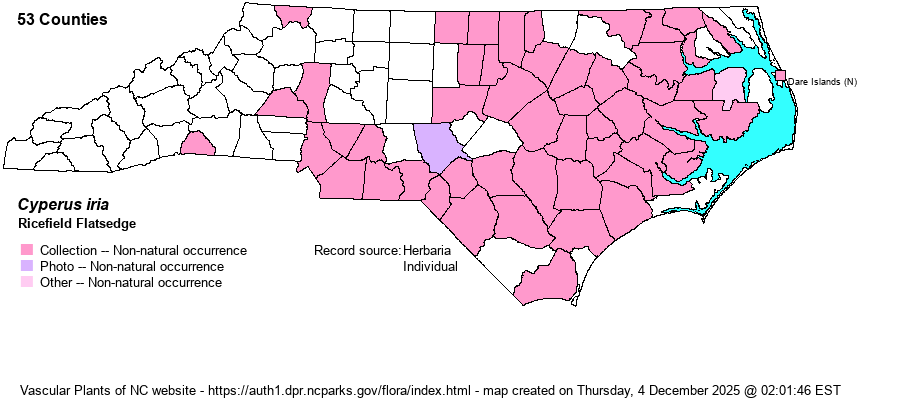| Author | L. | |
| Distribution | Mostly in the Coastal Plain, Sandhills, and lower Piedmont; scarce westward.
Native to the Old World; introduced to the U.S. as early as the 1840s with rice cultivation. Now found from NY and IL south to FL and TX. | |
| Abundance | Rare in the Mountains, uncommon in the Sandhills and Piedmont; frequent to common in the Coastal Plain. | |
| Habitat | Disturbed soil of fallow fields, cropfields, lawns, yards, etc. | |
| Phenology | Flowering and fruiting July-October. | |
| Identification | Rice-field Flatsedge is unique - and quite handsome! - in its combination of rich golden brown or reddish brown floral scales and broadly elliptical to sub-orbicular florets. | |
| Taxonomic Comments | The genus Cyperus is mostly tropical and warm-temperate in distribution; thus, in NC it is much commoner in the Coastal Plain than in the Mountains and Piedmont. Most species have 1-few flowering stems (culms) from grasslike basal leaves, plus a few stem leaves. At the summit is an inflorescence of very open and branched, or tightly packed, spikes, varying among species from brown to golden brown to straw-color to reddish. The arrangement of the spikelets is important, whether like a hand (digitate) or in paired or alternate rows (pinnate); as is the shape of the achene (seed), whether bi-convex in cross-section or triangular. As a group, Cyperus tends to be weedy and readily enters disturbed ground; this is true for many natives as well as all the aliens. In recent years, following DNA research, the genus has incorporated several genera that in RAB (1968) or other manuals were separate: Hemicarpha, Lipocarpha, and Kyllinga. | |
| Other Common Name(s) | | |
| State Rank | SE | |
| Global Rank | GNR | |
| State Status | | |
| US Status | | |
| USACE-agcp | FACW link |
| USACE-emp | FACW link |

